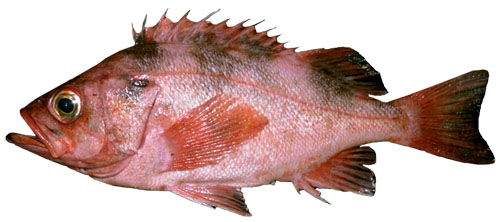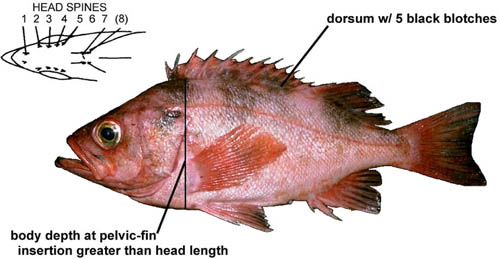|

The darkblotched rockfish (Sebastes crameri)
is also referred to as blackblotched rockfish, blackmouth rockfish, and
blotchie in British Columbia, among other names. Sebastes crameri
is named after Frank Cramer, a Stanford University rockfish biologist
from the 1800s.
In nature, the juveniles appear white with a dark blotch on the gill
cover. They have 4-5 wide vertical bars of brown or reddish brown; one
bar of which is on the head, while the others extend down from the
dorsal fin almost to the belly. The underwater adults have brown bars
and are white or pink in color, turning pink to orange with 3-5 dark
saddle marks after capture. Jet black blotches may be present on some
individuals. The similar
sharpchin rockfish is distinguished from the darkblotched rockfish by having
a distinct "<" mark under their eyes, and thinner short vertical bars
that extend barely below the lateral line. Darkblotched rockfish have been
recorded as large as 23.2 in. (58 cm) and aged to 105 years.
The range of the darkblotched rockfish extends from the eastern Bering
Sea and Aleutian Islands to southern California. They are most
abundant from British Columbia to central California. Although most
darkblotched rockfish live at depths ranging from 462 ft. to 693 ft. (140-210
m), they have been found at depths between 83 ft. and 2,982 ft. (25-904 m). Young
darkblotched rockfish are found at shallower depths than many other
rockfishes, often perching on the highest bit of available benthic
habitat structure. They have also been seen around the bottoms of
deepwater oil platforms. As they age this species moves to deeper depths, and are typically
found resting on mud near boulders or cobble, not usually rising above
the seafloor. They feed mainly in the midwater on krill, gammarid,
amphipods, copepods, salps, and sometimes octopi and other fishes. The
juvenile darkblotched rockfish are prey to albacore and chinook salmon.
Depending on the geographic location, the maturity age and size of both
sexes of darkblotched rockfish vary. Males grow to maximum length faster than
females, while females are larger at any given age after maturity and
may live longer than males. Generally, darkblotched rockfish mate between August
and December, with egg fertilization occurring from October to
March. Females produce about 20,000 to 610,000 eggs, and release the
larvae in one batch between November and April (as late as June off
British Columbia).
While they are sometimes taken off Alaska, this species is most
important to the commercial trawl fisheries between British Columbia and
northern California, and are considered overfished. They are mainly the
bycatch of other rockfishes off Washington and Oregon.
Darkblotched rockfish are insignificant as a recreational catch.
Adapted from Love, M. 2002 Sebastes crameri, p. 158-159. In M. S. Love,
M. Yoklavich, and L. Thorsteinson, The rockfishes of the northeast Pacific. Univ. California Press.

AFSC
Rockfish Guide
|

